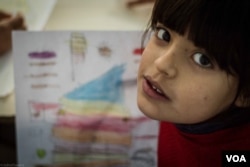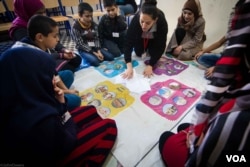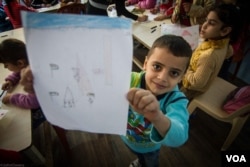Fondly swiping through images of home in Syria on her phone, Kenana Abd Almged only wishes her daughter could join her in remembering.
For seven-year-old Lamar, who left the country when she was three, home is the impoverished Beirut neighborhood of Shatila.
“When I ask her if she remembers our house and the shop she used to buy from, she says no,” explained Almged, who is from the Syrian city of Dara.
“If we go back one day, Lamar won’t remember anything about Syria and that is what I really feel sorry about.”
There are many children like Lamar. An estimated 6.6 million Syrians have been internally displaced, and another 4.3 million have been forced to flee the country, half of whom are thought to be children.
With the war now in its fifth year, a generation is growing up with no memory of its homeland.
Fading from memory
“The youngest generation of kids we work with left Syria when they were one or two and can’t remember anything about it,” said Ali Elshiekh Haidar, who works in Lebanon for non-government organization Najda Now.
“Anything they know of Syria came from the TV or their family, and it is mostly bad things.”
Najda Now runs a community center in Shatila, which was itself set up as a camp in 1949 for displaced Palestinians, a community that remains there to this day.
Among the center’s many activities for refugees are therapeutic drawing lessons designed to allow children to express their fears and dreams. In the early years of the war, pictures drawn included images of death and destruction.
Now, among younger generations, there is often no reference to Syria at all. Instead, Ali told VOA images are often about escapism, green fields, big houses and bright sunlight absent from the poverty-riddled Shatila.
Ali, however, says now there is a problem of identity. “When you ask where they’re from, they’ll say Shatila, or another camp [in Lebanon]. They are now children of the camps.”
Like strangers
Almged, who teaches drawing classes at the center, clings to the one memory her daughter does have of Syria, that of Lamar’s grandfather and his home.
“She wants to go to his house,” said Almged. “She remembers going to a fountain near the house with him by car.”
A Palestinian Syrian, she wants to join her husband who is waiting for her after making it to Sweden, and to help give Lamar a better life.
Almged, however, echoes fears voiced by Ali that even if things become safer in Syria, many among this new generation will not wish to return.
“They have become refugees and they don’t know if they would go back one day or not. This is the biggest problem,” she told VOA.
“They didn’t live in Syria and they don’t know it. If they go back one day, they will be like strangers.”
A future through the past
In Lebanon, where there are estimated to be 800,000 Syrian children displaced by the war, the government recently sought to increase the number of Syrians in education.
Many, however, remain outside of the system, and for those who are able to reach a school, there is little in the way of a systematic attempt to educate them about their heritage and homeland. Instead, programs like Syria in my Mind are attempting to step in to the gap, using the country’s ancient history as a way of securing its future.
Developed by NGO Biladi, the program uses games focusing on Syrian archeology to educate groups of children where illiteracy rates can reach as high as 90 percent.
Biladi president Joanne Farchakh Bajjaly explained the project’s focus in terms of the “monumental” and lasting role that sites like the Citadel of Aleppo and Palmyra played in the national consciousness.
“Contemporary history is always a matter of friction,” she said, adding that using ancient history also allowed children a way of understanding Syria, away from the conflict that has torn it apart.
“We try to re-link them to the Syria of their parents, the beautiful Syria before the war. The first question they [the children] often ask is, 'Is that really true? Is Syria really that pretty?'"
In two years the program, which is backed by UNICEF and Italian NGO AVSI, has reached about 3,000 children across Lebanon.
Bajjaly and her team are aiming higher. The hope, she said, is to have it introduced into the Lebanese school curriculum, so that children will be able to look beyond the confines of their immediate lives as refugees.
In the process, those like 7-year-old Lamar may be able to not just rediscover their homeland, but contribute to its future.
“One day the war will end, because nothing lasts for ever,” Bajjaly added. “Them knowing a positive Syria will enable them to go back and reconstruct it in a positive way.”












